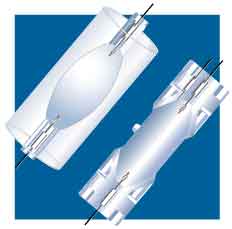| |
What is the
NEC?
The NEC
is administered by the National Fire Protection Association (NFPA)
and is revised every three years. The 2005 NEC has recently been
released for publication and is currently available from the NFPA
at www.nfpa.org.
What changed in the NEC?
The NEC change regarding open luminaires is the new section 410.73(F)(5)
that states, "Metal Halide Lamp Containment. Luminaires (fixtures)
that use a metal halide lamp other than a thick-glass parabolic
reflector lamp (PAR) shall be provided with a containment barrier
that encloses the lamp, or shall be provided with a physical means
that only allows the use of a lamp that is Type O." (See ANSI Standard
C78.387, listed in Resources, for more information on lamp types.)
Therefore, to
meet the 2005 NEC requirements, luminaires that use metal halide
lamps must either:
• Be enclosed to provide a containment barrier.
• Use
a special lampholder that will only accept an ANSI Type O rated
metal halide lamp.
When did
the 2005 NEC take effect?
January 1, 2005, but adoption of the it varies from state
to state. Based on adoption of the 2002 NEC changes, several states
could adopt the 2005 code immediately with approximately half the
states adopting in the first year.
How will
this change affect Venture?
Venture Lighting fully supports the NEC changes. They simplify the
metal halide systems options available and will also reduce the
potential risks associated with failure when properly following
the warnings and instructions for systems that specify open luminaires
with Type S lamps. All lamps produced by Venture Lighting meet or
exceed the requirements to receive an O rating, and can be used
with confidence to meet the new requirements of the NEC. Venture
Lighting provides the industry's widest selection of lamps that
meet or exceed ANSI C78.387 testing requirements for a Type O rating.
What is the
ANSI test?
The ANSI containment test was developed by the ANSI Standards Committee
C78 to determine if a lamp can be rated for open luminaire operation.
In the ANSI C78.387 test, arc tubes are forcibly ruptured to test
the integrity of the lamp, i.e. to determine if the design can be
containment-rated. In order to receive the "O" rating, the outer
bulb cannot be cracked or broken.
|
|
What is the
difference between "S" and "O" rated lamps?
ANSI lamp designations:
E - Lamps must be used in enclosed luminaires which meet
the requirements of UL1598.
S - Lamps are considered "suitable" for open luminaire operation,
only if operated in the vertical ±15° position. Lamps do not
meet ANSI criteria for containment and must be turned off at least
once per week for a minimum of 15 minutes if operated continuously.
In addition these lamps must be group relamped before reaching rated
lamp life.
O-Lamps can be operated in open or enclosed luminaires within
the manufacturer's specified operating position limits. This type
meets the ANSI criteria for containment rated operation. Special
exclusionary sockets are available for these lamps to ensure that
the wrong lamp type is not used.

O-rated
• Arc tube shroud
• Continuous
operation, no shut-off required (Venture only)
• Meets ANSI criteria for open fixture use
• Recommended by insurance industry
S-rated
• No shroud
• Must be operated ±15° of vertical
• Must be turned off 15 minutes, every week
• Does not meet ANSI test for open rating
• Not
recommended by insurance industry
What is Venture's
Policy about "S" rated lamps?
Venture Lighting does not participate in the practice of designating
any of their lamps with the "S" rating. Moreover, Venture offers
a broad selection of shrouded, open-rated lamps in its standard
(probe start), White-Lux®, Energy Master® and Uni-Form®
pulse start product lines. These Venture "O" rated lamps do not
need to be cycled in 24/7 operation.
|
|

